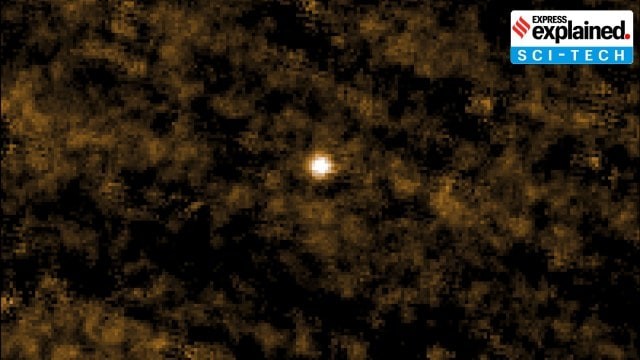Description

Disclaimer: Copyright infringement not intended.
Context:
- Astronomers are closely monitoring Eta Carinae, a hypergiant star with a mass approximately 100 times that of our Sun, as it may be on the verge of a spectacular explosion.
Introduction
- Eta Carinae is a hypergiant star located in the Carina constellation, approximately 7,500 light-years away from Earth.
- This celestial giant is one of the most massive and luminous stars known to science, with a mass around 100 times that of our Sun.
- Astronomers are closely monitoring it, as it may be on the brink of a spectacular explosion.
Characteristics of Eta Carinae
- Eta Carinae belongs to a class of stars known as hypergiants.
- These stars are extremely rare and are characterized by their immense size and luminosity.
- The star is part of a binary system, meaning it has a companion star with which it interacts gravitationally.
- This interaction plays a crucial role in its dramatic life cycle.
Historical Significance
- Eta Carinae has a history of remarkable activity.
- In the 19th century, it underwent a massive outburst, known as the Great Eruption, during which it temporarily became the second-brightest star in the night sky.
- This event released as much visible light as a supernova explosion.
- However, unlike a supernova, Eta Carinae survived, shedding a significant portion of its outer layers.
Potential for a Supernova
- Astronomers believe that Eta Carinae is nearing the end of its life cycle and may soon explode as a supernova.
- When a star of this magnitude reaches the end of its nuclear fuel, it undergoes a gravitational collapse, resulting in a colossal explosion.
- This event would be visible from Earth, providing a rare and remarkable cosmic spectacle.
Observational Efforts
- Currently, astronomers are using various ground-based and space-based telescopes to monitor Eta Carinae closely.
- The aim is to gather as much data as possible to understand its behavior and predict when the explosion might occur.
- Instruments like the Hubble Space Telescope and the Chandra X-ray Observatory are instrumental in these observations.
Scientific Importance
- The study of Eta Carinae is not just about anticipating a celestial show; it offers valuable insights into the life cycles of massive stars.
- Understanding its eventual explosion will help scientists learn more about the mechanisms of supernovae and the role such explosions play in the universe.
- Supernovae are essential for dispersing heavy elements across space, contributing to the formation of new stars and planets.
Possible Impact on Earth
- While the explosion of Eta Carinae would be a remarkable event, it is important to note that it poses no direct threat to Earth.
- Given its distance, the energy released would not affect our planet.
- Instead, it would provide astronomers with a unique opportunity to study a supernova in detail.
Conclusion
- Eta Carinae stands as a fascinating subject for astronomers and space enthusiasts alike.
- Its impending explosion represents a unique opportunity to witness an extraordinary cosmic event and deepen our understanding of stellar evolution.
- As we continue to observe this celestial giant, the anticipation of its final, grand performance grows ever more exciting.
ALSO KNOW ABOUT
|
Mission
|
Objective
|
Launch Year
|
Purpose
|
Completion Status
|
|
Apollo 11
|
Land humans on the Moon and return safely to Earth
|
1969
|
First manned lunar landing
|
Completed
|
|
Voyager 1
|
Explore the outer planets and interstellar space
|
1977
|
Study Jupiter, Saturn, and their moons; currently in interstellar space
|
Ongoing
|
|
Hubble Space Telescope
|
Observe astronomical objects beyond Earth's atmosphere
|
1990
|
Gather detailed information about celestial phenomena
|
Ongoing
|
|
Mars Rover Curiosity
|
Explore Mars' surface and assess its habitability
|
2011
|
Investigate Martian geology and climate
|
Ongoing
|
|
James Webb Space Telescope
|
Study the universe's formation and evolution
|
2021
|
Observe distant galaxies, stars, and planetary systems
|
Ongoing
|
|
Mars Perseverance Rover
|
Search for signs of ancient life on Mars
|
2020
|
Collect samples for potential return to Earth
|
Ongoing
|
|
New Horizons
|
Flyby of Pluto and the Kuiper Belt
|
2006
|
Study Pluto, its moons, and other Kuiper Belt objects
|
Completed (Pluto flyby in 2015)
|
|
Artemis I
|
Test systems for future crewed lunar missions
|
2022
|
Uncrewed mission to test Orion spacecraft and Space Launch System (SLS)
|
Completed
|
|
Chandra X-ray Observatory
|
Observe X-ray emissions from high-energy regions
|
1999
|
Study black holes, supernovae, and other cosmic phenomena
|
Ongoing
|
|
Parker Solar Probe
|
Study the Sun's outer corona
|
2018
|
Investigate solar wind and its impact on space weather
|
Ongoing
|
References
- "A star is rearing to explode. Earth will get a front-row seat to mega event," India Today, August 07, 2024.
- National Aeronautics and Space Administration (NASA) archives on Eta Carinae.
https://www.indiatoday.in/science/story/star-100-times-greater-than-the-sun-is-rearing-to-explode-anytime-2578260-2024-08-07
|
PRACTICE QUESTION
Q. Eta Carinae, often mentioned in astronomical studies, is significant because:
A) It is the closest known black hole to Earth.
B) It is a binary star system known for its dramatic variability and massive eruptions.
C) It is the largest known exoplanet in our galaxy.
D) It is a newly discovered supermassive star cluster.
Answer: B)
|










